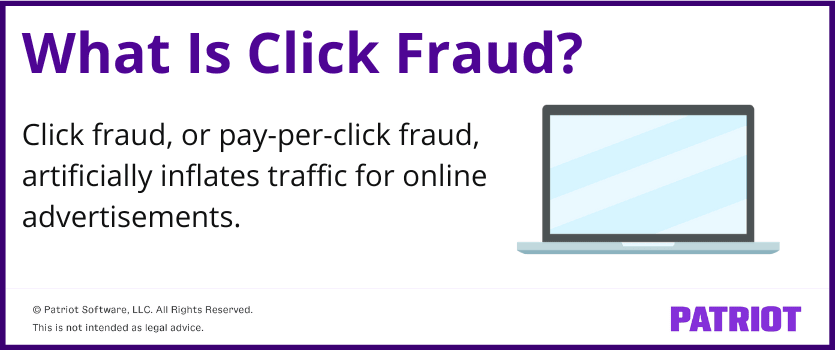Have you wondered how companies get their website to show up as an ad in search engines? Those ads are called pay-per-click ads (PPC). A company sets a budget, makes an ad, and each time a user clicks the ad, money comes out of the budget. As soon as there’s no more money in the budget, the ads stop. Pretty simple, right? But what if someone clicks the ad just to use up your PPC budget? That’s an example of click fraud, which can make it hard for your business to compete online. Read on to learn more about click fraud and how to protect your business.
What is click fraud?
Click fraud, or pay-per-click fraud, artificially inflates traffic for online advertisements. When a company uses PPC ads, it expects to pay for potential customers. Click fraud makes it appear that a large number of potential customers are interested in a company’s webpage. Not only can this burn through a company’s PPC ad budget, but it will also make your ad disappear from search results.
Click fraud happens when someone wants to:
- Increase the revenue of an ad hosting website (e.g., publisher click fraud)
- Help malicious websites rank higher in search results
- Exhaust the daily ad spend of a company (e.g., competitor click fraud)

How does click fraud hurt businesses online?
Chances are you’re already a victim of click fraud. Worse, you’re probably losing money. Ninety percent of all PPC ad campaigns on Google and Bing suffer from click fraud. And, if your company spends $10,000 a month on Google Ads, you may be losing between $12,000-$15,000 each year. That’s 10%-12% of your annual advertising budget.
Click fraud can also skew website analytics. Illegitimate clicks are part of your website analytics, just like the clicks that come from legitimate customers. It can be difficult, if not impossible, to understand how a display ad is doing if you can’t tell what activity is good or bad.
Types of click fraud
There are several types of click fraud you should know about. While many types of click fraud may not directly affect your business, you might want to steer clear of companies that practice click fraud.
Here are some types of click fraud to keep in mind:
- Click bots: This method uses bots to automate clicking on ads.
- Click farms: Similar to click bots, click farms hire people to click on ads.
- Crowdsourcing: Advertisers convince users to click on their ads, even though the users have no intention of buying the product advertised.
- Pixel stuffing: Publishers place an ad on a website inside a 1×1 pixel. The user doesn’t know it, but they’ve technically viewed an ad and generated revenue for the host website.
- Ad stacking: Similar to pixel stuffing, ad stacking places one ad on top of another. Again, the user technically views the ads without actually seeing them.
Want to impress your friends at a dinner party?
Get the latest small business news delivered straight to your inbox.
Subscribe to Email ListClick fraud examples
To get a better understanding of click fraud, let’s look at a few examples of click fraud in action. We’ll take a look at click fraud that:
- Increases the revenue of an ad hosting website
- Helps websites rank higher in search results
- Exhausts a company’s daily ad spend
1. Click fraud to increase revenue
The company Tangled Web sells space for display ads on its website. An advertising network like Google’s AdSense places a display ad on Tangled Web’s site.
After a certain number of users click on the ad, Tangled Web earns money. Because Tangled Web wants to make as much money as possible, they click on the banner ad as often as they can (e.g., using click bots or click farms). The artificial clicks look like real users, boosting Tangled Web’s ad hosting revenue and skewing the website analytics of the company that owns the display ad.
2. Click fraud to help websites rank higher
The Emperor’s Clothes is still struggling to rank on Google search results. They could do some search engine optimization and rank for keywords, but they decide to rank higher through click fraud instead.
For their plan to work, Emperor’s Clothes artificially boosts its click-through rate (CTR) on popular search engines. As the CTR of the website or ad increases, search engines increase the ranking of Emperor’s Clothes because the website appears to be useful for users.
3. Click fraud to exhaust a company’s daily ad spend
Montague Roasters and Capulet Coffee are fighting to control an already saturated market. To get ahead of the competition, Montague Roasters starts a PPC campaign on Google and Bing.
Once Capulet Coffee hears of Montague Roasters’ PPC campaign, they create a plan to slow down their rival. Capulet Coffee exhausts the daily ad spend of Montague Roasters by clicking on its PPC ads. The Capulet plan works. Not only do they stop the ads from appearing on search results, they also burn through the daily ad spend of Montague Roasters without giving them any new customers.
How to stop click fraud
Click fraud is bad news for business. Luckily, your business isn’t helpless when it comes to click fraud. With the right information, you can identify click fraud and prevent it.
Identify the click fraud
You want to make sure that your advertising budget is bringing new customers to your business. If click fraud eats through your advertising budget, it can negatively impact your business. Not only do you lose the chance to make a new conversion, but it may also impact your ad score, ensuring that your ad is shown less and your CPC goes up. The first step to preventing click fraud is identifying it as it happens.
When tracking the clicks for your ads, be on the lookout for:
- Continuous clicks from similar IP address
- Cost surges in your advertising budget that don’t match established patterns
- A high number of ad clicks without a corresponding increase in conversions
- A peak in impressions while page views drop
If you come across any of these situations, there’s a good chance you have a case (or cases) of click fraud. So, what now? How can you prevent click fraud?
Prevent click fraud
Most advertising networks already work hard to fight click fraud. For example, Google uses machine learning to find and stop suspicious activity. But you don’t have to depend on advertising networks to stop click fraud from affecting your business.
Here are a few steps you can take:
- Strategically block IP addresses. Go through your data to see if there are any suspicious-looking clicks. Look out for a high number of clicks at strange hours with little to no conversions. If these clicks come from the same IP address, there’s a good chance you have click fraud on your hands. Block the IP address through your advertising network and stop click fraud cold.
- Rethink display ads. If your display ads generate suspicious clicks, you may want to rethink using them. Thirty-six percent of display ads are fraudulent. Make sure that the right audience sees your ads. Targeted ads deliver ads to users that are likely to take action. Retargeted ads focus on users that have already viewed your website. Focusing your ads on a customer more likely to convert can help prevent click fraud.
- Use click fraud protection software. Click fraud protection software can take the guesswork out of fighting click fraud. If you’re losing money fast, software may be the perfect way to prevent click fraud.
This is not intended as legal advice; for more information, please click here.



